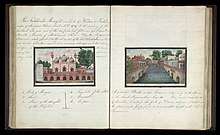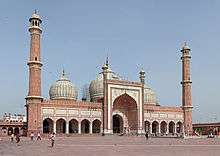Lal Masjid, Delhi
History
| Lal Masjid | |
|---|---|
 | |
 Location in Delhi, India | |
| Basic information | |
| Location | Delhi |
| Geographic coordinates | 28°39′55″N 77°13′47″E / 28.665186°N 77.229613°ECoordinates: 28°39′55″N 77°13′47″E / 28.665186°N 77.229613°E |
| Affiliation | Islam |
| Province | Delhi |
| Country | India |
| Architectural description | |
| Architectural type | Mosque |
| Architectural style | Indo-Islamic |
| Completed | 1729 |
The Lal Masjid (Urdu: لال مسجد, Hindi: ਲਾਲ ਮਸਜ਼ਿਦ, the "Red Mosque") of Delhi, also known as the Fakr-ul Masjid (Urdu: فخرالمسجدHindi: ਫ਼ਕਰੁਲ ਮਸਜ਼ਿਦ the "Pride of Mosques") or Sikandar Sahib's Masjid[1], is a mosque located in Bara Bazaar, Kashmiri Gate in Old Delhi. It was built in 1728-29 by Kaniz-i-Fatima (entitled Fakr-i-Jahan), in memory of her husband Shujaat Khan, a noble in Aurangzeb's court.[2] Colonel James Skinner repaired the mosque and its construction is sometimes misattributed to him.[1]
Illustrations and descriptions of the mosque were included in Sir Thomas Metcalfe's 1844 book "Reminiscences of Imperial Delhi."
In the 1857 Siege of Delhi the mosque was damaged, yet since then, has been repaired. [3]
Architecture
The mosque sits on a raised plinth of about 12 metres (40 ft) by 7.3 metres (24 ft) and stands 2.5 metres (8.2 ft) above the adjacent shop-lined streets.[4][5] The main complex consists of three rooms each with its own arched entryway. Two striped towers on either side of the center arch are mirrored by the mosque's two minarets standing at the rear corners of building. Behind a decorated parapet on the roof of the mosque sit three white and black marble domes.[5] The building's prominent use of red sandstone and white marble is considered unusual for the period, though many of its other features, including its minarets and domes, are closely modeled off of the major mosques of Delhi including the nearby Jama Masjid.[6]

References
- 1 2 Smith, R,V. Delhi: Unknown Tales of a City. Roli Books Private Limited. ISBN 9789351941255.
- ↑ Peck, Lucy; Heritage, Indian National Trust for Art and Cultural. Delhi, a thousand years of building. The Lotus Collection. ISBN 9788174363541.
- ↑ Keene, Henry George (1906). A Handbook for Visitors to Delhi and Its Neighborhood. Bombay: Thacker & Co. pp. 25–26.
- ↑ Stephen, Carr (1876). The Archæology and Monumental Remains of Delhi. Ludhiana: Thacker Spink & Co. pp. 270–271.
- 1 2 "Lal Masjid (Fakrul Masjid)". 2007-07-06. Retrieved 2018-09-30.
- ↑ 1946-, Asher, Catherine B. (Catherine Blanshard), (2006). India before Europe. Talbot, Cynthia. New York: Cambridge University Press. ISBN 0521809045. OCLC 61303480.
- https://ranasafvi.com/fakhr-ul-masajid/
- https://books.google.com/books?id=cN7-8ZwviRgC&pg=PA46&lpg=PA46&dq=Fakhr+ul+Masajid&source=bl&ots=vfKmLNsROj&sig=z7WqwhqFAXSdDQupbeswfytb4EQ&hl=en&sa=X&ved=2ahUKEwixmaaR-uHdAhWFMH0KHUTJCPUQ6AEwFHoECAAQAQ#v=onepage&q=Fakhr%20ul%20Masajid&f=false
- http://www.delhiunlimited.com/travel-and-tourism/places-of-worship/mosques/lal-masjid-delhi.htm
- http://www.bl.uk/onlinegallery/onlineex/apac/addorimss/t/019addor0005475u00048vrb.html
- http://www.rarebooksocietyofindia.org/postDetail.php?id=196174216674_10150316693141675

